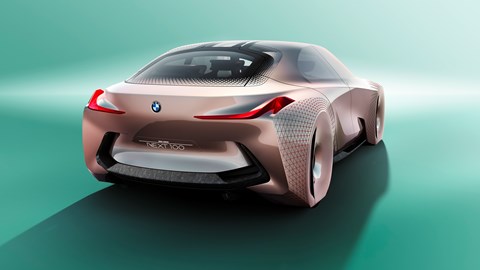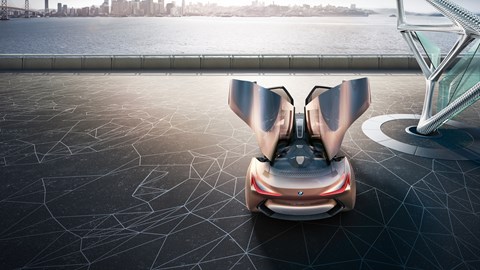► Autonomous concept for BMW’s centenary
► Previews near and distant-future technology
► Autopilot driving modes, configurable interior
BMW has unveiled a spectacular future-gazing concept car at a special event celebrating the Munich marque’s centenary.
Click here for CAR’s live blog, direct from the event.
The BMW Vision Next 100 concept, as its name suggests, is a crystal-ball exercise to look at the kind of BMW models we could be driving (or, more to the point, be driven by) in the future.
I take it the BMW Vision Next 100 can drive itself, then?
It can. But it also allows the driver to take control in a manual driving mode, too. Such a large part of BMW’s brand image is bundled up in cars that are entertaining to drive that the company suggests its future cars will need to be geared as much towards being driven by their owners as driving themselves autonomously.
‘In recent months and years, the greatest current trend in the automotive industry has become so widespread that it’s no longer a question of ‘if’ but ‘when’ for autonomous driving,’ says BMW. ‘BMW drivers will be able to let their cars do the work – but only when the driver wants.’
The Vision Next 100 is designed around two driving modes: ‘Boost’ and ‘Ease’. In Boost mode the driver is in control, while in Ease mode the steering wheel and centre console retract, the seats swivel to allow the driver and front passenger to chat, and the car takes over the driving.
See the video below to see the different driving modes in action:
There’s no missing that grille…
The trademark ‘kidney’ grille remains, in supersized and illuminated form, but it’s no longer there to cool radiators. Instead, it houses a host of sensors to support the autonomous control systems, and its colour changes to let other road users know whether the car is in manual or autonomous mode.
Hydrogen fuel cells? Batteries? Turbines? BMW won’t name a specific drivetrain system for the car; its team of ‘future gazers’ are loathe to predict the definitive propulsion system of the future. Either way, it doesn’t look like there’s much room for a combustion engine under that low nose (which reminds us a little of the original M1 concept) or behind the rear seats – and BMW says the Vision Next 100 is a zero-emissions car.

At 4.9m long, its four-door, B-pillarless body is similar in size to a current BMW 5-series, yet BMW claims interior space equivalent to a 7-series. BMW claims a slippery drag coefficient of 0.18Cd, thanks in part to moveable bodywork that continually covers the wheels as they steer. Work is said to be already underway on production-engineering the fairing system.
What’s it made from?
Predominantly composites, including carbonfibre. BMW suggests that steel part presses will become obsolete at some point in the future, with rapid manufacturing and ‘4D printing’ taking a wider production role. By 4D printing, BMW means adding a moving function to 3D printed components, integrated with the car’s electronic control systems.
For instance, parts of the Vision Next 100’s interior architecture are designed to change shape, using a system BMW calls ‘Alive Geometry;’ 800 moving triangles set into the instrument panel move in various different choreographed ways, described as being similar to a flock of birds in flight, gesturing information to the driver’s peripheral vision in tandem with the head-up display. Certain movements would warn of oncoming vehicles, or signal the ideal driving line in Boost mode, or warn occupants of upcoming braking manouvres in self-driving Ease mode. Watch the video above to see an example of how the system can work.
So when the Vision Next 100’s not controlling itself, what would it be like to drive?
BMW claims the Vision Next 100’s technology could actually improve its driver’s skills. It’s designed to learn about the person at the wheel, using a system called ‘the Companion’ (shades of 2001: A Space Odyssey’s Hal, perhaps? Let’s hope not…)
Replacing conventional instruments and screens, the entire windscreen becomes a giant display. In manual ‘Boost’ mode, graphics show the ideal line through a corner, entry speed and steering angle – a bit like playing a computer game on ‘beginner mode.’ Graphics can also indicate hazards approaching in low-vision conditions, such as fog, or turn into a tour guide in Ease mode, highlighting buildings and landmarks of interest as the car passes by.
Regardless of the concept’s sentient ‘Companion’ tech, BMW is adamant that ‘in the future, BMW drivers will still want to spend most of the time they are in their car at the wheel.’
This won’t necessarily be the last Vision Next concept from BMW Group; it’s understood that equivalent concepts for the Mini and Rolls-Royce brands are coming soon too.
